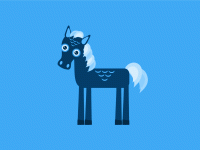Productive PD: Learning by Doing
Just like students, teachers also learn best by doing. Read how five horses (yes, horses!) participated in a teacher professional development about student motivation.
Your content has been saved!
Go to My Saved Content."Are you kidding me?" I thought when the instructor gave the task. There's no way that we are going to be able to stay together and lead all five horses with only thin pieces of curling ribbon. One of the horses had already refused to follow a teacher with a rope. How were we going to get him to follow with only a piece of ribbon?
Learning Horse Sense
This was by far the most interesting and enjoyable professional development that I have ever attended. The Equine Assisted Growth and Learning Association (EAGALA) is designed to help teachers be sensitive to student needs and explore alternatives for motivating students in the classroom. It takes place in a large, sand-filled barn, known as the Learning Lab, behind an elementary school.
The instructor, Janice McDaniel, is a district employee who brings her own fully-grown horses, also district employees, to help with the training. This day, she had brought five horses: a Quarter Horse, two Arabians, and two Appaloosas. Each beautiful horse weighed over 1500 pounds and, for us uninitiated teachers, were seriously daunting creatures.
Ten of us teachers attended the training, and we were given tasks to help us feel comfortable around our horses, such as brushing them and leading them to different parts of the barn. It was disconcerting at first when the horses walked away while we were brushing them. What are you going to do? Stand in front of this large animal and tell him, "I'm not done with you. Get back here!"
We learned quickly that the horses had minds of their own. They had their own agendas, and they took care of their own needs on their schedule -- much like students. One horse, who we called Bucky, flat out refused to follow the teacher. The teacher had done everything that all the other teachers had done to lead their animal to the designated spot in the arena, but this one did not want to cooperate. The teacher tugged, coerced, patted, and tugged some more, but the horse refused to budge.
The final task was to create, as a group, an obstacle course that represented what we did as teachers. We put our heads together and came up with a learning progression for learning languages (most of us were foreign language teachers). Then Janice, our trainer, gave us each a four-foot, flimsy piece of ribbon, the kind you use to decorate packages by curling it. She instructed us that we now had to lead all of the horses with this ribbon and stay connected to each other as we went through the obstacle course we had just made. We considered the problem and realized that all of the horses would follow except for Bucky. How were we supposed to get him to follow?
Follow the Leader
In a brilliant flash of inspiration, we thought that if we had the other horses go first, Bucky would get the idea and follow along. One by one, we connected teachers to horses and each other, with Bucky in the rear. Voila! Bucky followed right along. It wasn't easy going though the obstacle course. When one horse stopped to take care of business, we all had to stop until the horse started again, and we took care to step around what was left on the ground. At times, I and the other teachers had our arms as far apart as they could go -- the flimsy ribbons stretched to the maximum. Miraculously, they did not break, and we were all able to get through the obstacle course successfully.
What We Learned That Day
In the debriefing session with Janice, we discussed what the horses had taught us. We learned that patience, perseverance, and problem solving were much more valuable than authority, demands, and brute force. Our horses taught us that students have needs, and once their needs are taken care of, business can resume without a hitch. Just like our training horses, most students will follow our lead, and with some forethought, we can usually find a way to get them to participate in the learning.
Getting those large horses to follow us seemed an impossible task, but we accomplished it. Perhaps the most important thing we learned in doing so was that for students to learn, it is a cooperative endeavor with lots of give and take from everyone. The EAGALA training brought about a change in my attitude towards students and learning in a powerful and enjoyable way that I will never forget.
What has been your most productive professional development? Please share in the comments section below.
